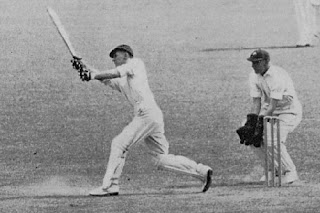Spoiler alert - this post contains referene to proper cricket and cricketers.
 |
| How corona spreads exponentially - R=2 |
From the cricketer's point of view, R below 1 would be a considerable achievement in any spell of more than one or two overs. The spinner who is tossed the ball for that single over before lunch and bowls a maiden doesn't really count. But FB can remember playing alongside a young left armer, who has since gone on to greater things but was still in primary school that day as he made his senior debut, who walked off with magical figures of 3-3-0-4. R well below 1.
FB's contribution in that match was 3-18 - a respectable R for him - it could have been even more respectable as all his wickets came in one over - a triple wicket maiden. Maybe this was the nearest he ever got to R equal to one, but he had to spoil it with these other overs. At the other end of the scale, FB cannot recall the most runs he ever conceded in a spell - this is still subject to the Official Secrets Act. He thinks that the most runs he ever conceded in a single over was 27 which was less than fun, although the batsman seemed to enjoy himself. In Test cricket such a going over has actually been exceeded - three times as it happens. RJ Petersen, who had the misfortune to encounter Brian Lara in full flow, Jimmy Anderson, who suffered under the cosh of George Bailey, and earlier this year, Joe Root, who was given the treatment by Keshav Maharaj, all went for 28 off a single over. FB modestly suggests that this is not a bad trio to be better than.
The highest number of runs conceded in a single Test innings was by Australian Chuck Fleetwood-Smith conceded 298 runs at the Oval in 1938 - England topped 900 and Len Hutton scored 364. Though Chuck's R is stratospheric, he bowled 87 overs so his economy rate was a relatively respectable 3.62. The highest number of overs bowled in an innings was by Sonny Ramadan at Edgebaston in 1957. He bowled 98 overs and had a parsimonious economy rate of 1.82 - much nearer to what the epidemiologists would like to see.
On the whole, it is perhaps as well that cricketers are not in charge of the pursuit of R below 1.
 |
| Hutton demolishing Fleetwood -Smith's R |

I still remember Gary Sobers' famous demolition of Malcolm Nash in a Glamorgan match. I think that was the first occasion in a 1st class match where 36 was scored in one over. Presumably FB has not suffered that fate at least.
ReplyDeleteIndeed batsmen have been too kind to him.
Delete